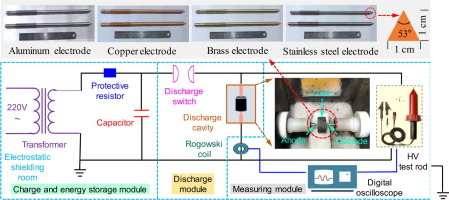Our official English website, www.x-mol.net, welcomes your feedback! (Note: you will need to create a separate account there.)
Experimental study on the effects of electrode materials on coal breaking by plasma
Fuel ( IF 7.4 ) Pub Date : 2020-06-01 , DOI: 10.1016/j.fuel.2020.117085 Xiangliang Zhang , Baiquan Lin , Yanjun Li
Fuel ( IF 7.4 ) Pub Date : 2020-06-01 , DOI: 10.1016/j.fuel.2020.117085 Xiangliang Zhang , Baiquan Lin , Yanjun Li

|
Abstract The extensively applied plasma technology boasts potential application prospects in the field of coal seam permeability enhancement. However, the effect of electrode materials on coal breaking by plasma (CBP) has not been reported. For this reason, the effects of four kinds of electrode materials, namely aluminum, copper, brass and stainless steel, on CBP were investigated by using a self-built CBP experimental system. The experimentally obtained statistics show that the sizes of coal fragments differ under the action of different electrodes. Specifically, the coal sample tends to be broken into small particles under the action of aluminum electrode, whereas the broken fragments generally have a diameter of larger than 15 mm under the action of brass electrode. The scanning electron microscopy results suggest that the different electrode materials correspond to different modes of crack initiation on coal surface. The results of liquid N2 adsorption show that the aluminum electrode exerts the poorest effect on improving micro-pores in coal, while the copper electrode achieves the best effect. Furthermore, the effects of electrode materials on the current and voltage waveforms at different voltages were analyzed by using a Rogowski coil and a HV test rod, and the effects of electrode materials on deposited energy generated by plasma in the coal were also discussed. The results indicate that at low voltages, the voltage and current waveforms under the action of four electrode materials differ obviously; in contrast, at high voltages, the voltage and current waveforms become almost identical. At the same voltage, the deposited energies formed by different electrode materials also differ due to the difference in breakdown voltages and current waveforms. The deposited energies formed by the aluminum electrode, the brass electrode and the stainless steel electrode inside the coal fall first and then rise with the increase of breakdown voltage, whereas that formed by the copper electrode goes up gradually with the increase of breakdown voltage. Based on the photograph of plasma discharge process shoot by a high-speed camera, the law of plasma propagation inside the coal was analyzed, and the effects of electrode materials on plasma development were discussed. A plasma streamer which is accompanied by dazzling white light and extremely high temperature is formed inside the coal at the moment of discharge, and it continuously expands outward as time passes by. The brightness degrees of plasma streamers formed under the action of electrode materials are different. Among the four electrode materials, the brass electrode forms the brightest light and generates the greatest energy.
中文翻译:

电极材料对等离子破煤影响的实验研究
摘要 广泛应用的等离子体技术在煤层渗透率增强领域具有潜在的应用前景。然而,电极材料对等离子破煤(CBP)的影响尚未见报道。为此,利用自建的CBP实验系统研究了铝、铜、黄铜和不锈钢四种电极材料对CBP的影响。实验得到的统计数据表明,在不同电极的作用下,煤碎片的大小不同。具体来说,煤样在铝电极的作用下容易破碎成小颗粒,而在黄铜电极的作用下,破碎的碎片一般直径大于15mm。扫描电镜结果表明,不同的电极材料对应于煤表面不同的裂纹萌生模式。液氮吸附结果表明,铝电极对改善煤中微孔的效果最差,而铜电极的效果最好。此外,利用罗氏线圈和高压测试棒分析了电极材料对不同电压下电流和电压波形的影响,并讨论了电极材料对煤中等离子体沉积能量的影响。结果表明,在低电压下,四种电极材料作用下的电压和电流波形明显不同;相反,在高电压下,电压和电流波形变得几乎相同。在相同电压下,由于击穿电压和电流波形不同,不同电极材料形成的沉积能量也不同。煤中铝电极、黄铜电极和不锈钢电极形成的沉积能随着击穿电压的增加先下降后上升,而铜电极形成的沉积能随着击穿电压的增加而逐渐上升。基于高速相机拍摄的等离子体放电过程照片,分析了等离子体在煤内的传播规律,讨论了电极材料对等离子体发展的影响。放电瞬间,煤内部形成一道伴随着耀眼白光和极高温度的等离子流光,并且随着时间的推移不断向外扩展。在电极材料的作用下形成的等离子流光的亮度程度是不同的。在四种电极材料中,黄铜电极形成的光最亮,产生的能量最大。
更新日期:2020-06-01
中文翻译:

电极材料对等离子破煤影响的实验研究
摘要 广泛应用的等离子体技术在煤层渗透率增强领域具有潜在的应用前景。然而,电极材料对等离子破煤(CBP)的影响尚未见报道。为此,利用自建的CBP实验系统研究了铝、铜、黄铜和不锈钢四种电极材料对CBP的影响。实验得到的统计数据表明,在不同电极的作用下,煤碎片的大小不同。具体来说,煤样在铝电极的作用下容易破碎成小颗粒,而在黄铜电极的作用下,破碎的碎片一般直径大于15mm。扫描电镜结果表明,不同的电极材料对应于煤表面不同的裂纹萌生模式。液氮吸附结果表明,铝电极对改善煤中微孔的效果最差,而铜电极的效果最好。此外,利用罗氏线圈和高压测试棒分析了电极材料对不同电压下电流和电压波形的影响,并讨论了电极材料对煤中等离子体沉积能量的影响。结果表明,在低电压下,四种电极材料作用下的电压和电流波形明显不同;相反,在高电压下,电压和电流波形变得几乎相同。在相同电压下,由于击穿电压和电流波形不同,不同电极材料形成的沉积能量也不同。煤中铝电极、黄铜电极和不锈钢电极形成的沉积能随着击穿电压的增加先下降后上升,而铜电极形成的沉积能随着击穿电压的增加而逐渐上升。基于高速相机拍摄的等离子体放电过程照片,分析了等离子体在煤内的传播规律,讨论了电极材料对等离子体发展的影响。放电瞬间,煤内部形成一道伴随着耀眼白光和极高温度的等离子流光,并且随着时间的推移不断向外扩展。在电极材料的作用下形成的等离子流光的亮度程度是不同的。在四种电极材料中,黄铜电极形成的光最亮,产生的能量最大。



























 京公网安备 11010802027423号
京公网安备 11010802027423号